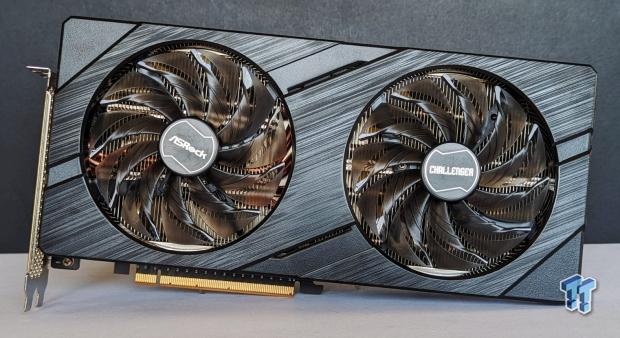
The Bottom Line
Pros
- + $179 price point!
- + 20% faster than the GeForce RTX 3050
- + Surprisingly decent ray-tracing performance
- + High-quality design and build from ASRock
- + Intel Arc drivers continue to improve
Cons
- - 2 x 8-pin connectors for an entry-level GPU
- - Although improved, Arc drivers still have a ways to go
- - Requires Resizable BAR, so it's not a great option for older systems
Should you buy it?
AvoidConsiderShortlistBuyIntroduction
Most PC gamers aren't rocking rigs with GeForce RTX 4090s or even something like a GeForce RTX 3070 or RTX 3080. Granted, these are popular for high-end PC gaming and dominate the discourse. However, gaming on the absolute best is a luxury; most gamers use entry-level, mainstream, and sometimes mid-range GPUs. The only problem is that entry-level and mainstream prices have increased alongside the 4090s in the world. The idea that NVIDIA or AMD would release a sub $200 graphics card in 2024 focused on giving entry-level gamers or those on a budget a game-changing bang-for-your-buck GPU - is, sadly, a fantasy.
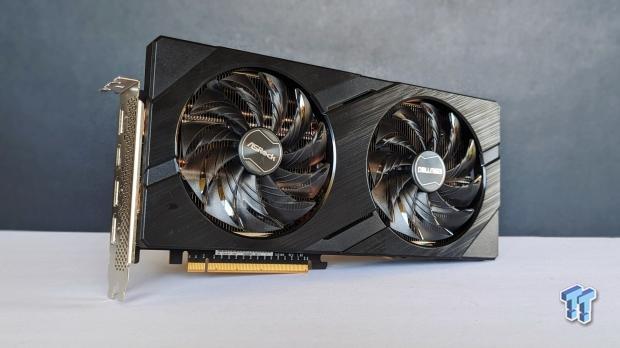
When the $179 USD Intel Arc A580 launched in October 2023, our review of a SPARKLE model highlighted just how rare it was. A brand-new SKU squarely focused on 1080p gaming performance that beat the GeForce RTX 3050 - NVIDIA's budget and entry-level RTX offering. Budget and value for money are important, especially for newcomers and youngsters getting their first taste of PC gaming.
So, after putting one Intel Arc A580 to the test, it's great to see the ASRock Intel Arc A580 Challenger 8GB OC finally in action.
A compact dual-fan design that leans into the company's reputation and reliability regarding things like thermal design and style. The Challenger Series might be the more budget and affordable range in ASRock's GPU arsenal (the design is very minimal), but that doesn't mean it has cut corners with the build - you've still got things like the premium power delivery and fans designed to maximize airflow.
At this point, you're probably wondering what sort of performance you can get for $179. You might also think that being faster than the GeForce RTX 3050 isn't all that impressive. The short answer is 1080p 60fps performance in demanding titles with ultra or high-quality settings enabled.

Intel Alchemist Enters the Race
Below is a summary of the Intel Arc technology, applicable to all models.
The debut of the Intel Arc A750 and Intel Arc A770 graphics cards for desktops in 2022 marked Intel's arrival into the discrete GPU space. Not only that, but the appearance of new architecture from Intel designed for gaming, creation, and AI applications called Xe HPG - with that last bit standing for High-Performance Graphics. Like NVIDIA and AMD, Intel has spent the time and resources to develop its own Xe HPG graphics architecture with an approach that features some genuinely new ideas that deliver scalability from laptops up to high-end desktops.
Compared to the single measure of NVIDIA's CUDA Cores and AMD's Compute Units, Intel's Xe HPG architecture breaks down its technological blocks into 'Render Slices' - with each one containing four Xe Cores, four Ray Tracing Units, and the general building blocks of what make up a modern-day GPU. As brand-new architecture, Xe HPG has been built from the ground up with DirectX 12 Ultimate in mind, meaning that all Arc-based GPUs can handle the challenging task of real-time ray-tracing and use DX12 features like Variable Rate Shading and other bits of rendering technology.
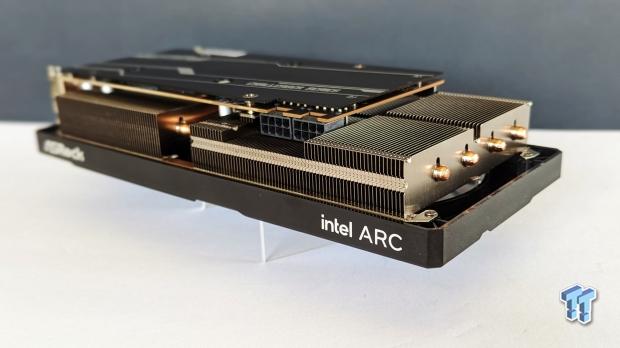
Xe HPG architecture is built for AI, with dedicated AI hardware ala NVIDIA's Tensor Cores in the GeForce RTX range. Each Xe Core (there are four of these in each 'Render Slice') features hardware built for traditional rasterization tasks but also Intel Xe Matrix Extensions (Intel XMX) Engines capable of handling machine-learning tasks. This directly ties into Intel's XeSS rendering, which, like DLSS, uses AI to upscale. However, it isn't exclusive to Intel Arc GPU hardware; it is AI-based and benefits from Intel's accelerated machine learning via the Intel Arc series, but it is designed to work on all GPUs.
As mentioned above, each 'Render Slice' also features dedicated ray-tracing hardware. Beyond this, there's a unique Thread Sorting Unit designed to help with efficiency and be able to do other tasks simultaneously to improve RT and other performance.
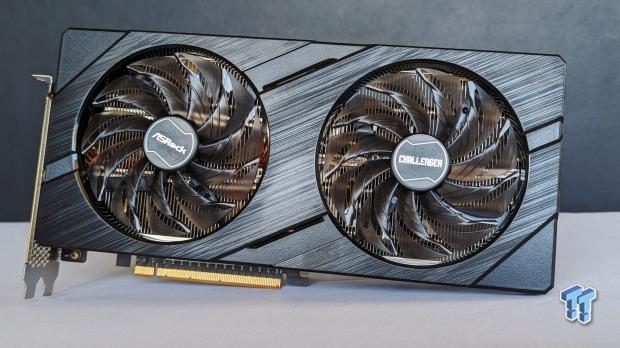
A shared cache can also be used for any compute workload, shading task, or in-game texture-related thing. For creators, the Xe media engine offers hardware-accelerated AV1 encoding with support for encoding and decoding up to 8K with VP9, AVC, HEVC, or AV1.
As a brand-new piece of architecture, Intel has designed Xe HPG for modern-day gaming and graphics card usage. From playing visually stunning titles with ray-tracing, competitive shooters like Counter-Strike 2, or simply watching or even streaming content - it's all here, including support for DisplayPort 2.0.
Specs and Test System
Specifications
Intel's Arc Xe HPG architecture puts all the performance hardware in what the company calls 'Render Slices.' Looking at the Intel Arc A580, Arc A750, and Arc A770 specs, you only see a single Render Slice increase as you move up the stack. That said, this houses all of Intel's Xe Cores, Ray Tracing Units, and AI hardware - and the difference between the A580 and the A770 is a 33.3% increase in overall specs.
Funnily enough, this is reflected in the 1080p gaming performance, more or less. Intel's Arc lineup seems to be tailor-made for the entry-level and mainstream market.
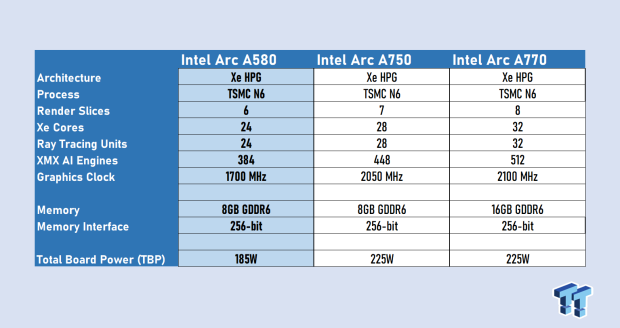
With a power rating of 185W, the Intel Arc A580 is the most power-efficient GPU in the Arc lineup, but it does fall behind the GeForce RTX 3050 in this regard - the Arc A580 uses more energy to deliver more performance. To the tune of roughly 30%, so it's worth highlighting.
One area where the Intel Arc A580 and other cards in the lineup excel is in the memory department. Even though you're looking at 8GB of GDDR6 memory, that's 16 Gbps memory delivered on a 256-bit bus. So you've got considerably more memory bandwidth than the GeForce RTX 4060 and Radeon RX 7600, with the same overall capacity. As an OC model, the ASRock Intel Arc A580 Challenger pushes the reference clock speed of 1700 MHz up to 2000 MHz, which is an impressive bump and nice to see.
- GPU: Intel Arc A580 Graphics
- Model: ASRock Intel Arc A580 Challenger 8GB OC
- Interface: PCI Express 4.0
- Microarchitecture: Xe HPG
- Render Slices: 6
- Xe-cores: 24
- Ray Tracing Units: 24
- Intel Xe Matrix Extensions (Intel XMX) Engines: 384
- Xe Vector Engines: 384
- Graphics Clock: 2000 MHz
- Memory: 8GB GDDR6
- Memory Speed: 16 Gbps
- Memory Interface: 256-bit
- Total Memory Bandwidth: 512 GB/s
- Display Connections: 3 x DisplayPort, 1 x HDMI
- TBP: 185W
- Recommended PSU: 650W
- What's in the Box: ASRock Intel Arc A580 Challenger 8GB OC
Kosta's Test System
- Motherboard: MSI MPG X670E Carbon Wi-Fi
- CPU: AMD Ryzen 9 7900X
- Cooler: Corsair iCUE H100i RGB PRO XT Liquid CPU Cooler
- RAM: 64GB (2x32GB) Corsair DOMINATOR PLATINUM RGB DDR5 DRAM 5200MHz
- SSD: Sabrent Rocket 4 Plus-G M.2 PCIe Gen 4 SSD 4TB, Sabrent Rocket 4 Plus Plus M.2 PCIe Gen 4 SSD 8TB
- Power Supply: Thermaltake Toughpower GF1 850W
- Case: Thermaltake Core P3 Tempered Glass Snow
- OS: Microsoft Windows 11 Pro 64-bit
Physical Design and Cooling
The ASRock Intel Arc A580 Challenger 8GB OC design is an all-black GPU without RGB lighting in a no-fuss, minimal, and compact package that should fit most small builds. The front shroud is where you find the two axial fans that feature a 0dB mode - meaning they only start spinning when the temperature breaches a certain threshold. The all-black look finish has some minimal flourishes, different finishing, some patterns, transparent fans, and chrome fins - stuff that adds up to make it a clean-looking GPU.
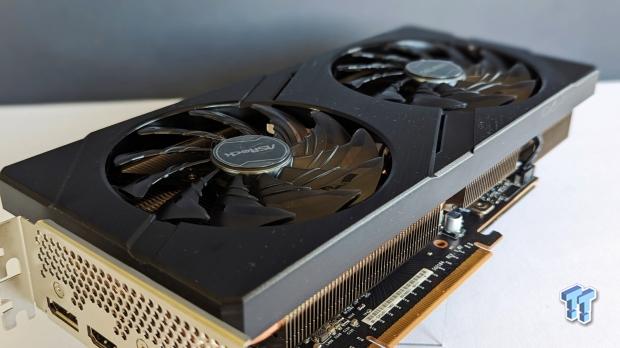
For an entry-level GPU, it's also good to see ASRock include a metal backplate, which is limited to the size of the PCB - a potential cost-cutting measure that adds an open-back feel to the design that looks great. Surprisingly, like the SPARKLE model we reviewed, this is another Intel Arc A580 GPU with 2 x 8-pin power connectors - which is a shame, as it does limit the upgrade potential for some. Rated at 185W, surely Intel could have chosen a single 8-pin and board power combo like other affordable GPUs.
Elsewhere the GPU design features flat heat pipes for maximum GPU contact, nano thermal past, premium thermal pads for components, and ASRock's 'precise screw torque' to optimize mounting pressure. Port-wise, you've got 3 x DisplayPort 2.0 and 1 x HDMI 2.0b connection. The card's overall dimensions are 271 x 132 x 48 mm with a 2.4-slot thickness - not the smallest, but something you'd still consider small for a GPU in 2024.
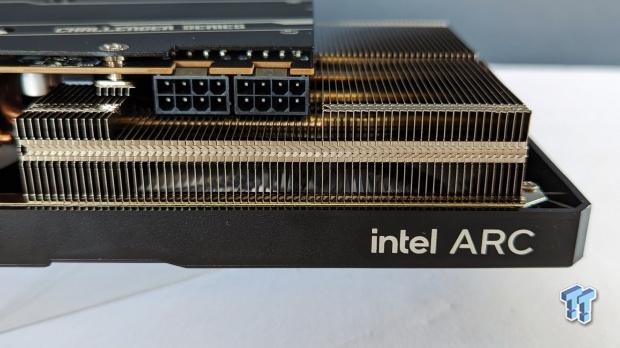
As a smaller GPU, it does run hotter than something with three fans and a chunky heatsink, but even so, the fan speed remains in check, and overall noise levels - even when stressed, remain low.
Benchmarks - 15 Game Averages
The Games and Tests
In 2023, PC gaming is a complicated and varied space, from indie games to major blockbuster releases and titles that push hardware and technology to their limit with the adoption of effects like real-time ray-tracing.
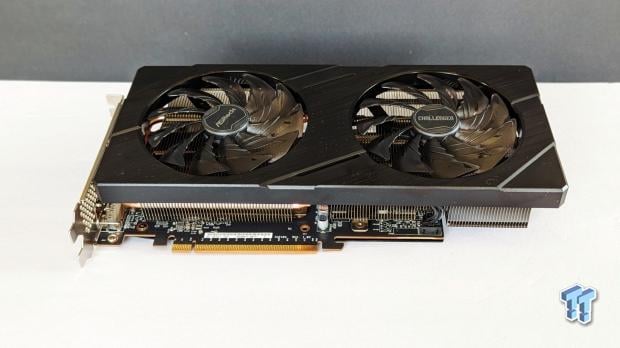
This is all a way of saying that the 15 in-game benchmarks we've chosen (and run at 1080p and 1440p) represent a wide range of styles, not only in terms of genres, like first-person shooters and racing games but also in the API technology (DirectX 11, 12) and cutting-edge features like ray tracing and upscaling technology.
Results include DLSS, XeSS, and FSR 2, where possible, as these technologies are the sorts of things, especially in 1440p and 4K, which you'd turn on. Six of the 15 game benchmarks also feature ray tracing. Also, each title is set to ultra-equivalent quality settings to push GPU hardware and minimize CPU bottlenecks at higher resolutions.
Also, it's just fun to max out a game's visual settings and see the results. Here's the breakdown of games, graphics settings, and what's being tested.
- Assassin's Creed Valhalla: Ultra High-quality settings, with the in-game benchmark tool used.
- Borderlands 3: Ultra quality settings, with the in-game benchmark tool used.
- Call of Duty: Modern Warfare II: Ultra quality setting, in-game multiplayer benchmark tool used. AMD FSR, Intel XeSS, and NVIDIA DLSS results are included.
- Cyberpunk 2077: Ultra quality setting, in-game benchmark tool used. AMD FSR, Intel XeSS, and NVIDIA DLSS results are included.
- Cyberpunk 2077 (RT): Ray tracing Ultra quality setting, in-game benchmark tool used. AMD FSR, Intel XeSS, and NVIDIA DLSS results are included.
- DOOM Eternal (RT): Ultra Nightmare quality setting with ray-tracing enabled, the opening of Mars Core campaign level used to benchmark. NVIDIA DLSS results are included.
- F1 22 (RT): Ultra High-quality setting with ray tracing, one lap of the Bahrain track benchmarked. AMD FSR and NVIDIA DLSS results are included.
- Forza Horizon 5 (RT): Extreme quality setting with ray tracing enabled, in-game benchmark tool used. AMD FSR, Intel XeSS, and NVIDIA DLSS results are included.
- Hitman (RT): Ultra-quality settings with ray-tracing, Dubai scene benchmarked. AMD FSR, Intel XeSS, and NVIDIA DLSS results are included.
- Horizon Zero Dawn: Ultimate quality setting, in-game benchmark used.
- Marvel's Guardians of the Galaxy (RT): Ultra quality setting with ray tracing enabled, the in-game benchmark tool used. NVIDIA DLSS results are included.
- Rainbow Six Extraction: Ultra quality settings and in-game benchmark tool used. NVIDIA DLSS results are included.
- Red Dead Redemption 2: Maximum quality settings, with in-game benchmark tool used. AMD FSR and NVIDIA DLSS results are included.
- The Division 2: Ultra quality settings with in-game benchmark tool used.
- Total War: Warhammer III: Ultra-quality settings with the in-game Battle Benchmark tool used.
15 Game Average FPS - 1080p Results
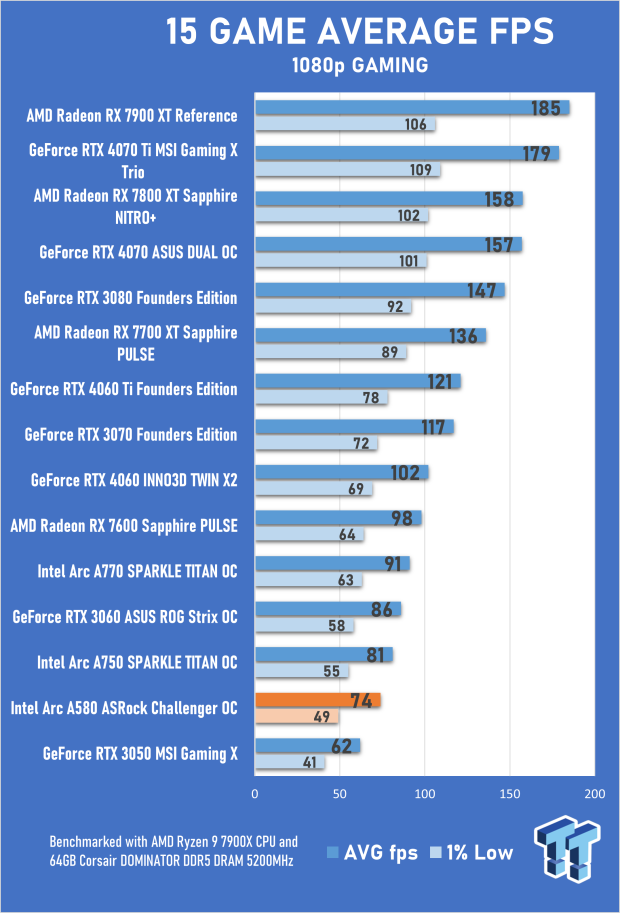
This card is tailor-made for entry-level gaming, so its 1080p performance is arguably the most important; the average frame rate of 74 fps across our 15-game benchmark suite makes it 19.4% faster than the GeForce RTX 3050. This makes it only 8.6% slower than the Intel Arc A750 for 1080p gaming and 14% slower than the GeForce RTX 3060 12GB. All our tests (granted, some of these titles are a few years old now) crank the visual settings to Ultra-level, which means the ASRock Intel Arc A580 Challenger 8GB OC is more than capable of powering everyday gaming. And when it comes to esports titles, it easily pushes performance into triple-digit territory.
You might think that enabling ray tracing on an entry-level card like the Intel Arc A580 would be a mistake, but you'd be wrong. Games like F1 22 and Hitman can natively hit and stay at around 60fps, outperforming cards like the Radeon RX 7600 and, in some cases, the GeForce RTX 3060. Intel's ray-tracing performance across the entire Arc lineup is competitive, so it would be amazing to see what the company could pull off with a mid-range or high-end GPU.
15 Game Average FPS - 1440p Results
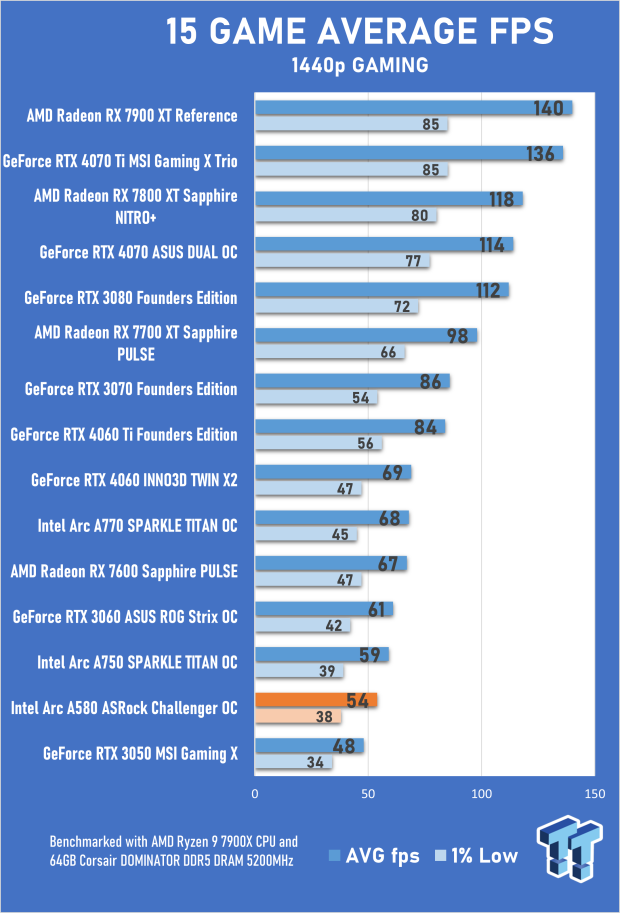
Bumping up the resolution to 1440p and the performance drop-off for the ASRock Intel Arc A580 Challenger 8GB OC is roughly 27%, which is pretty respectable. The increased memory bandwidth and speed help, but they're not enough to guarantee 60fps performance in most titles. There are some exceptions here, too. DOOM Eternal hits 87fps (outclassing the Radeon RX 7600 once again), and the Rainbow Six Extraction result indicates that esports titles will still run fine at 1440p on the Intel Arc A580.
Intel XeSS, the company's AI-powered upscaling, definitely comes in handy at this resolution as the image quality is impressive at 1440p and something you would enable to boost performance in titles where it's available. For 1440p gaming across our 15-game benchmark suite, the ASRock Intel Arc A580 Challenger 8GB OC is 12.5% faster than the GeForce RTX 3050 (its lead shrinking) and 8.5% slower than the Intel Arc A750.
Benchmarks - 3DMark FireStrike
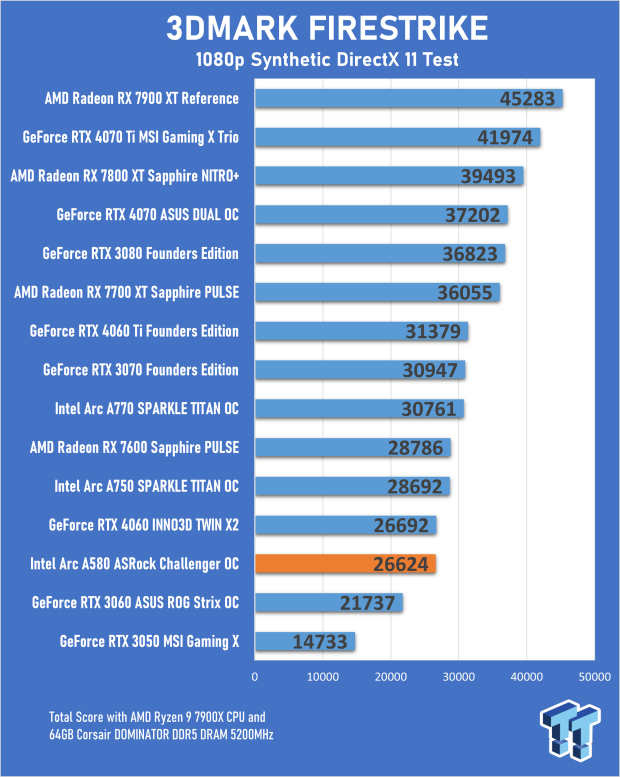
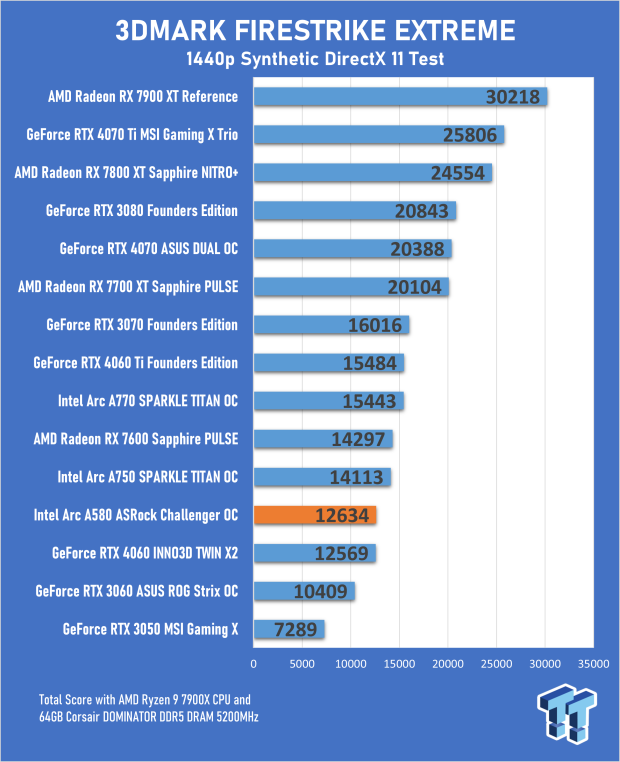
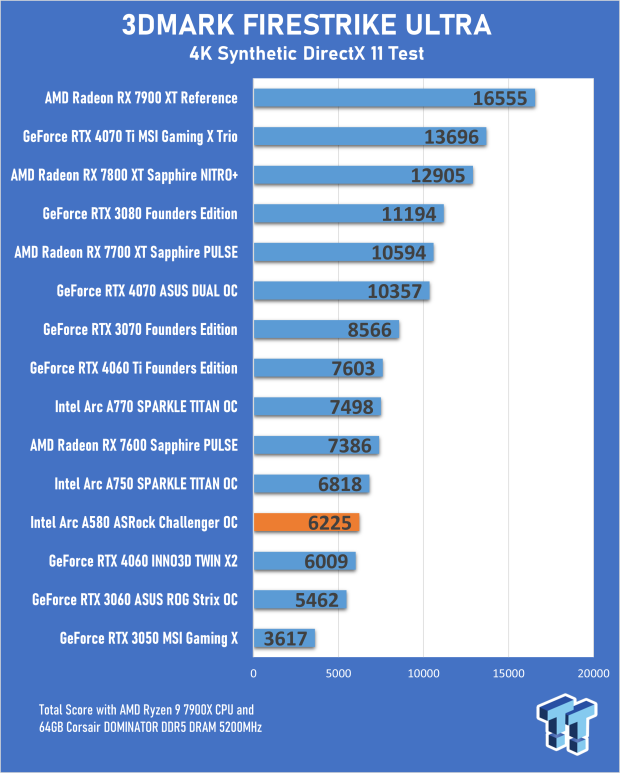
Something is going on with Intel Arc, as the 3DMark results for all models tell a very different story to in-game benchmark results. 3DMark FireStrike test, a DirectX 11 benchmark covering 1080p, 1440p, and 4K resolutions, makes it look like performance is identical or on par with the GeForce RTX 4060. According to our in-game benchmark results, it's roughly 27.5% slower for 1080p gaming.
Since launching the Arc lineup in 2022, Intel has worked hard to improve performance and stability, especially for older titles whose tech and engines didn't gel well with the architecture. Perhaps there's some untapped potential, but it's unlikely when you consider that even the Intle Arc A770, with its 16GB of VRAM, trails the RTX 4060 in performance.
Benchmarks - 3DMark TimeSpy and Port Royal
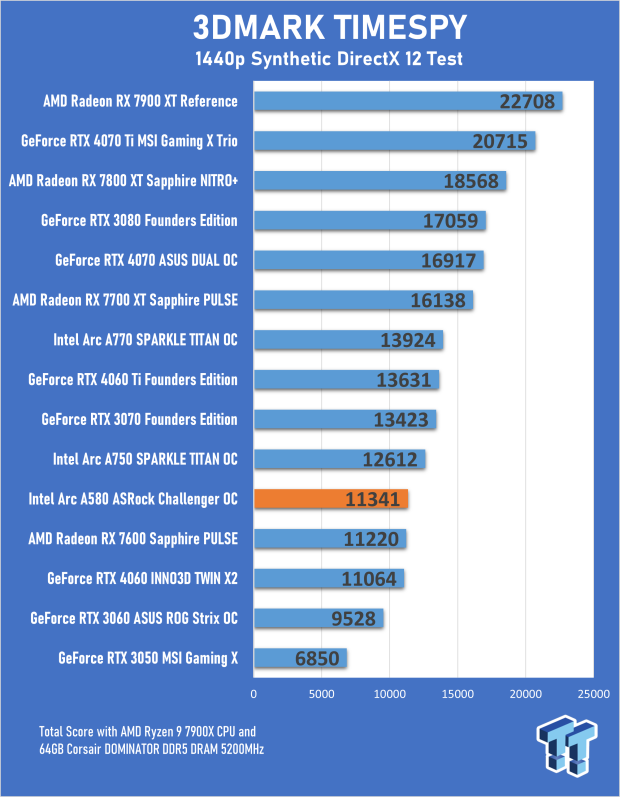
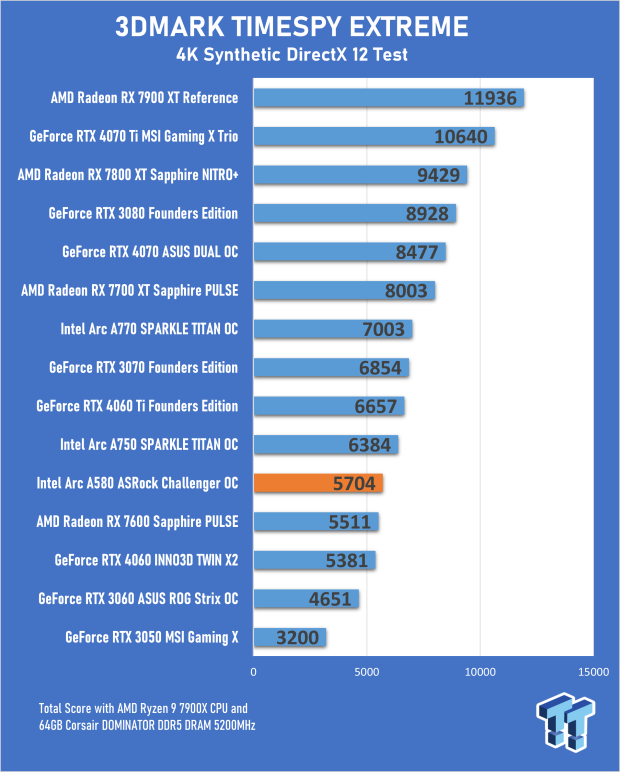
3DMark TimeSpy is a synthetic DirectX 12 benchmark and a more relevant test for modern games and Intel's Arc range, which was designed and built to take advantage of modern PC gaming. Again, the results here don't paint a real-world story but show that the Intel Arc A580 is faster than the GeForce RTX 4060 and Radeon RX 7600. Albeit not by a lot, the results are definitely in a different performance tier than where the card sits.
As highlighted earlier, there are games where the Intel Arc A580 does outperform the Radeon RX 7600 - Hitman with ray-tracing and Red Dead Redemption II with max settings.
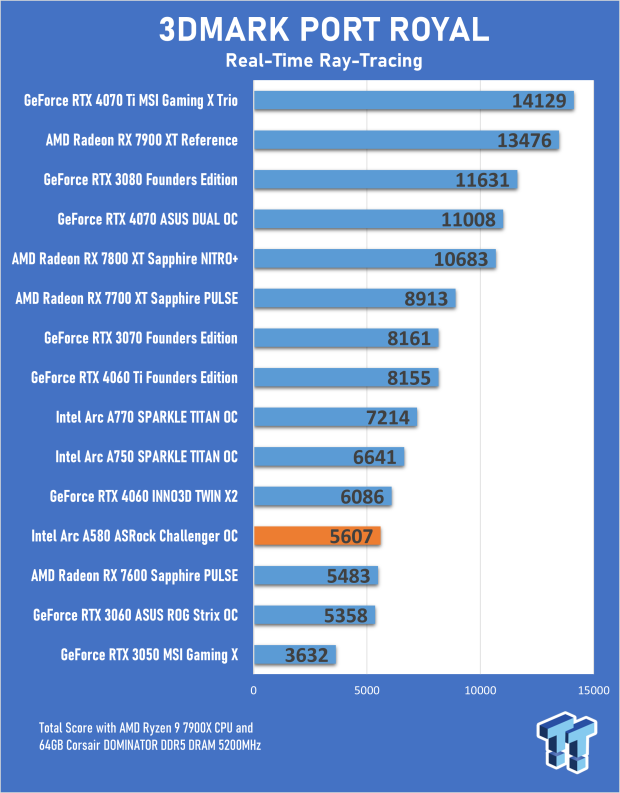
3DMark Port Royal is a synthetic ray-tracing benchmark, and even though the ASRock Intel Arc A580 Challenger is a surprisingly decent ray-tracing performer, beating the Radeon RX 7600, it's not quite at the greater than GeForce RTX 3060 levels indicated by the result. It's additional proof that Intel is ahead of AMD regarding ray tracing, where even the entry-level Arc GPU can outperform the mainstream Radeon RDNA 3 card.
The good news is that this isn't limited to titles with only small amounts of ray-tracing but games with multiple RT effects like Hitman. The results are high enough to give NVIDIA pause to realize that impressive hardware-accelerated ray-tracing isn't limited to GeForce. And hopefully, it will give AMD a wake-up call to step up its game big time with RDNA 4.
Benchmarks - 1080p Gaming
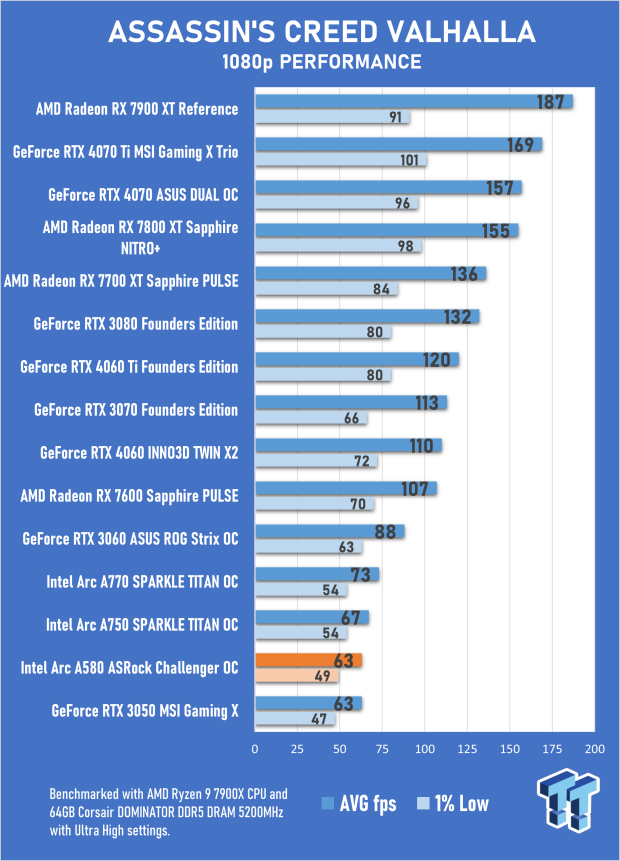
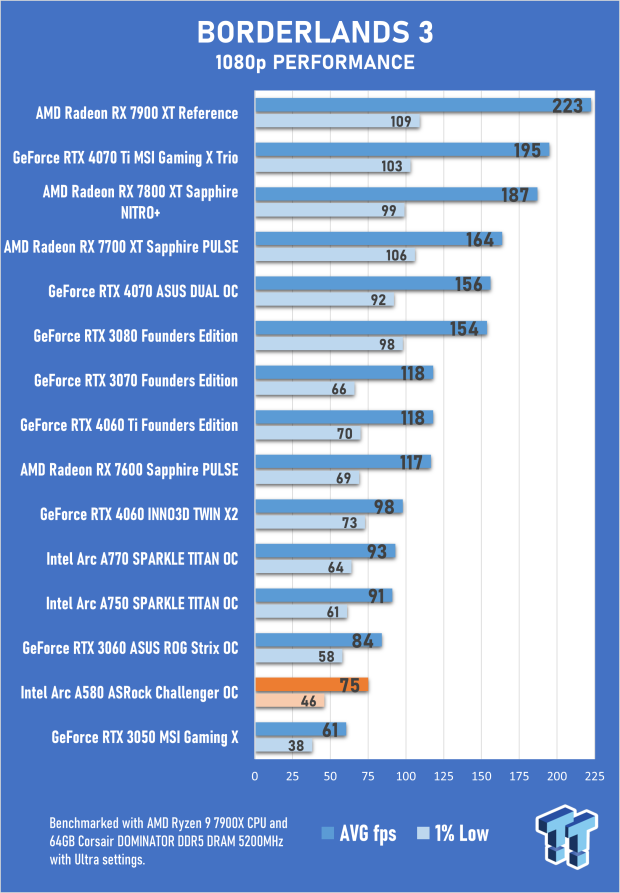
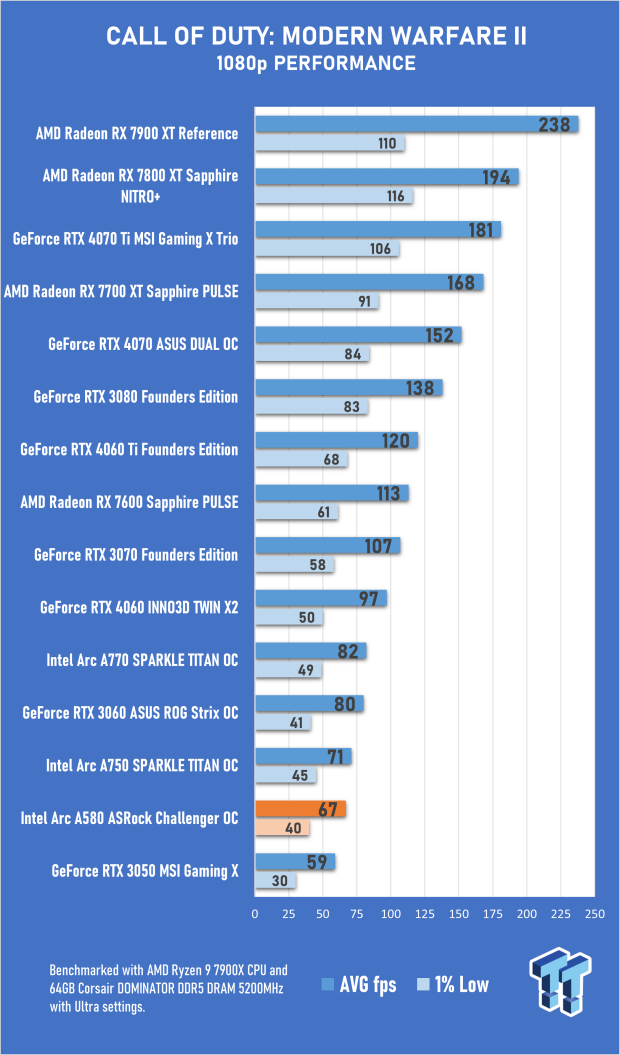
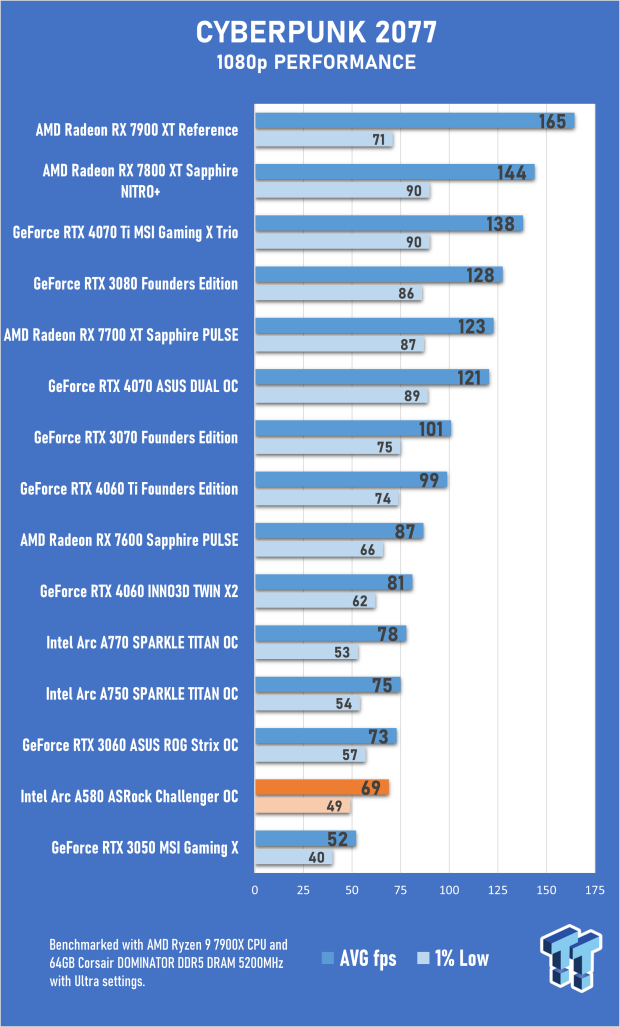
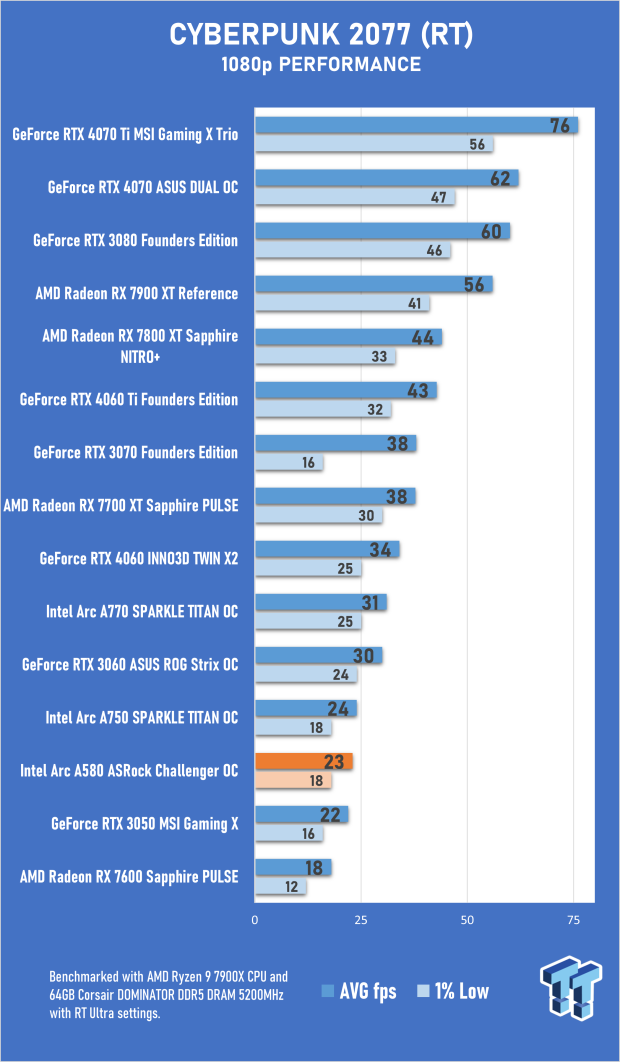
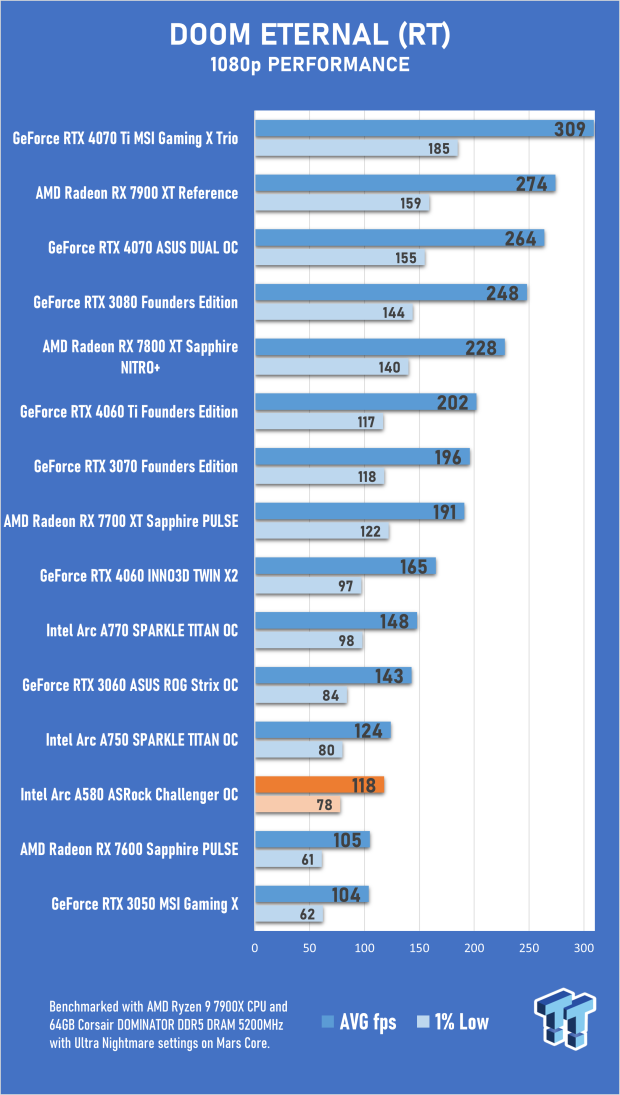
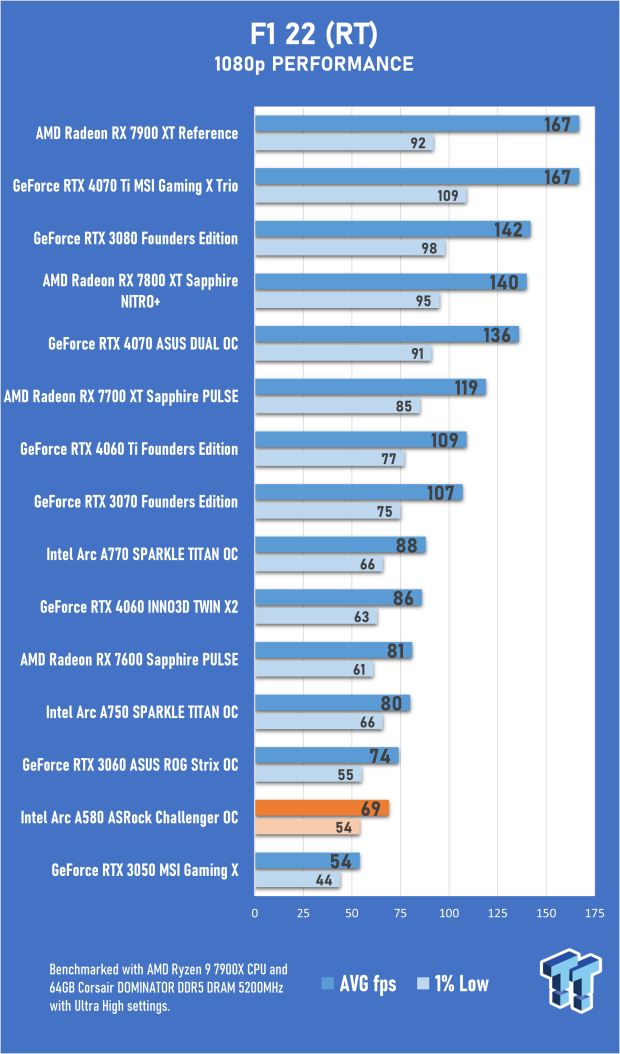
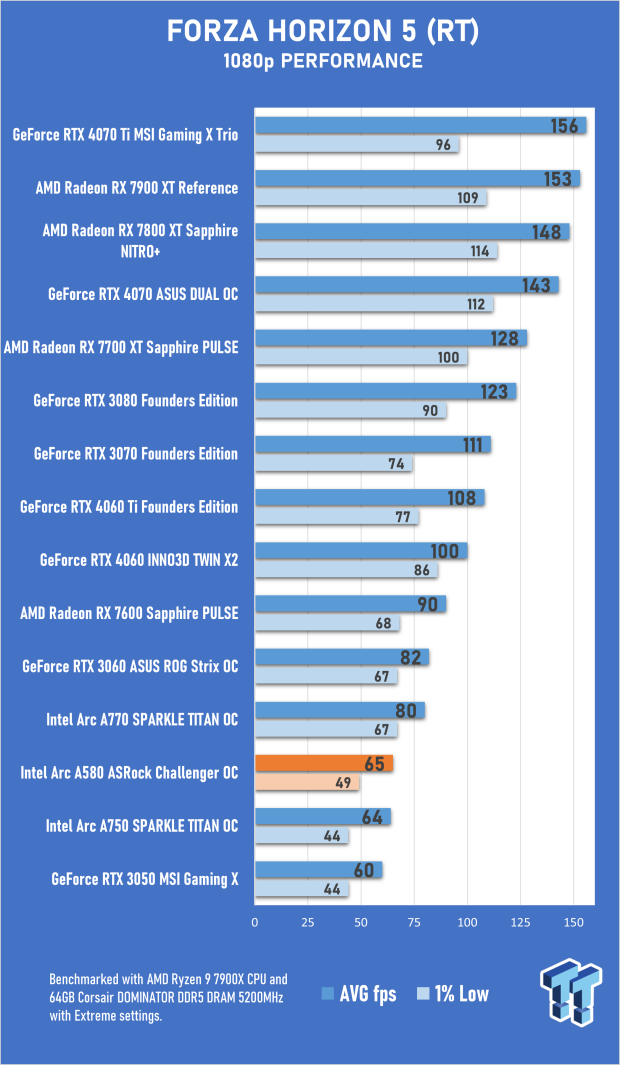
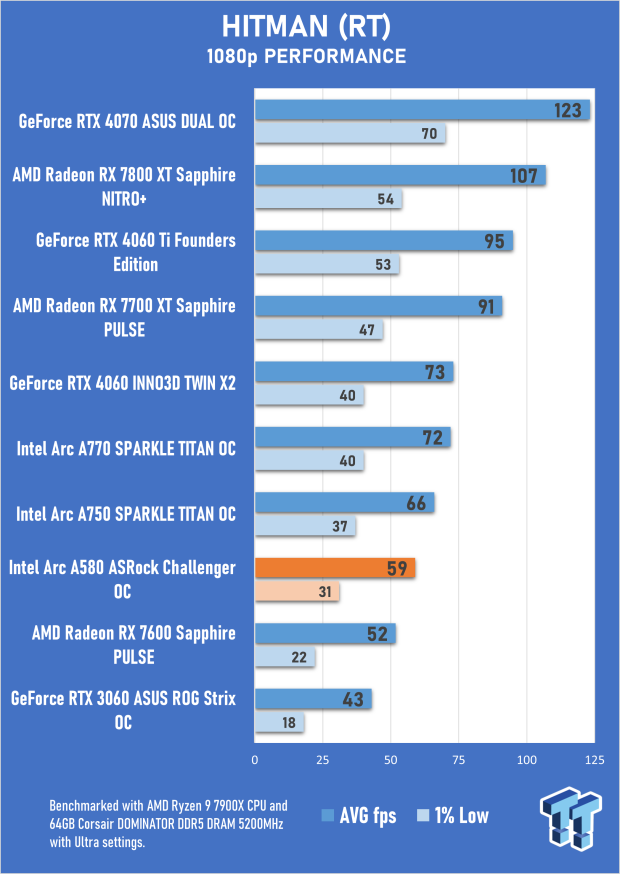
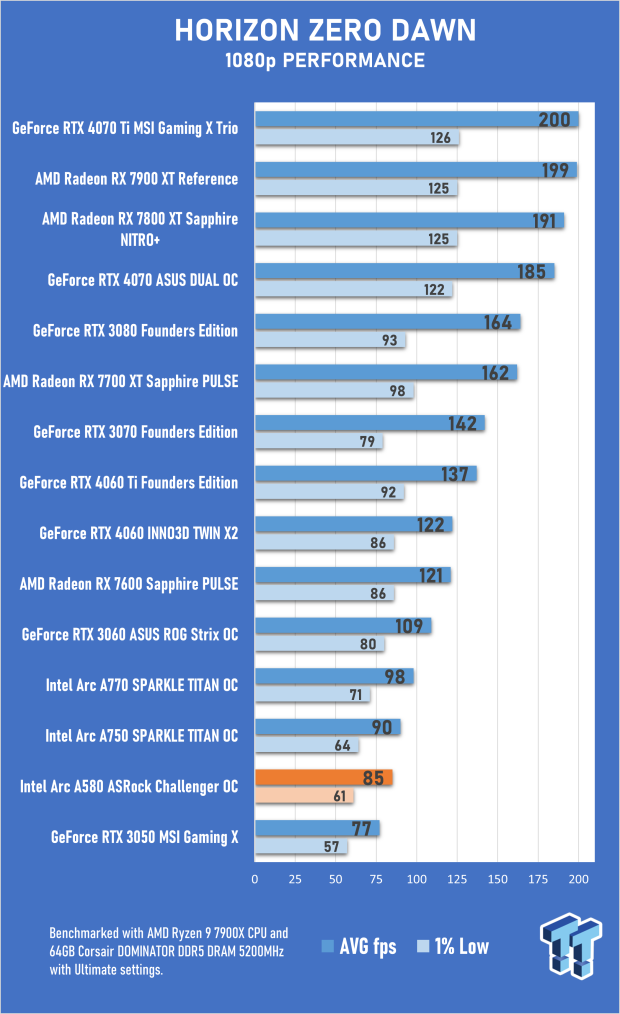
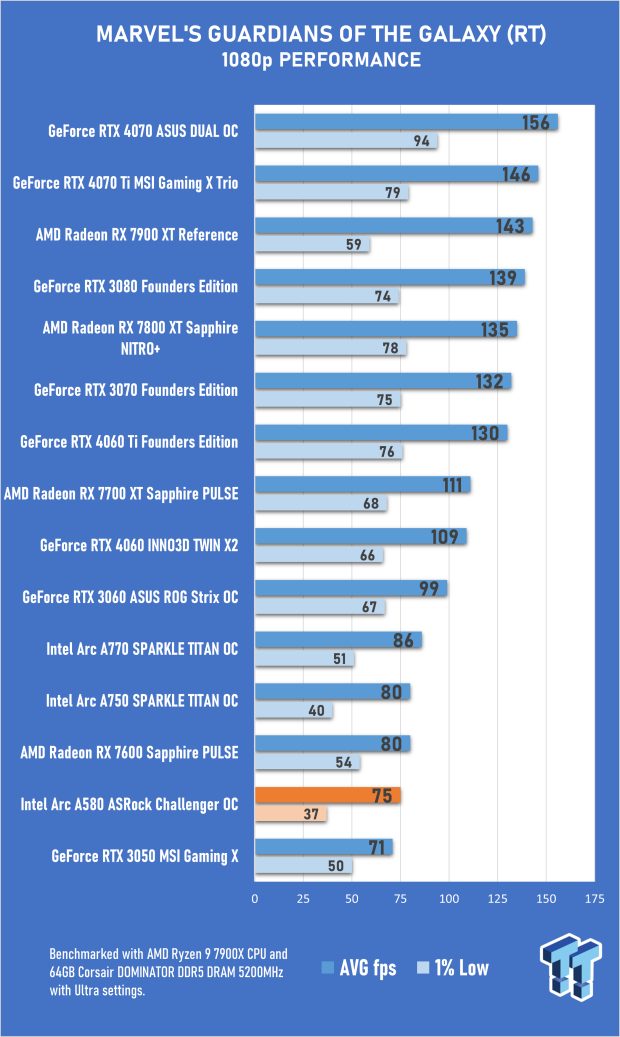
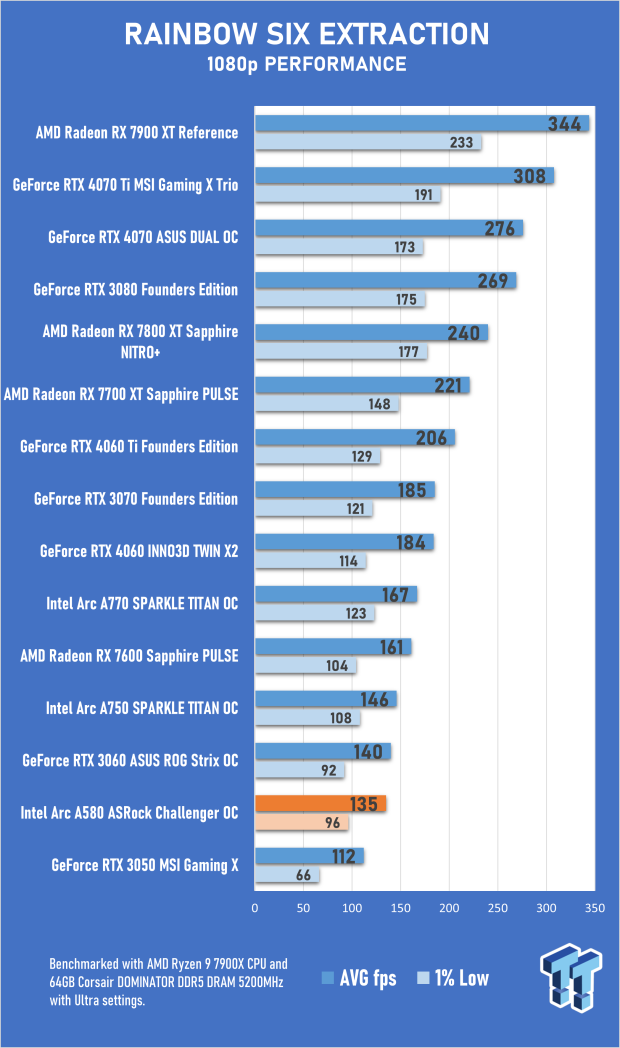
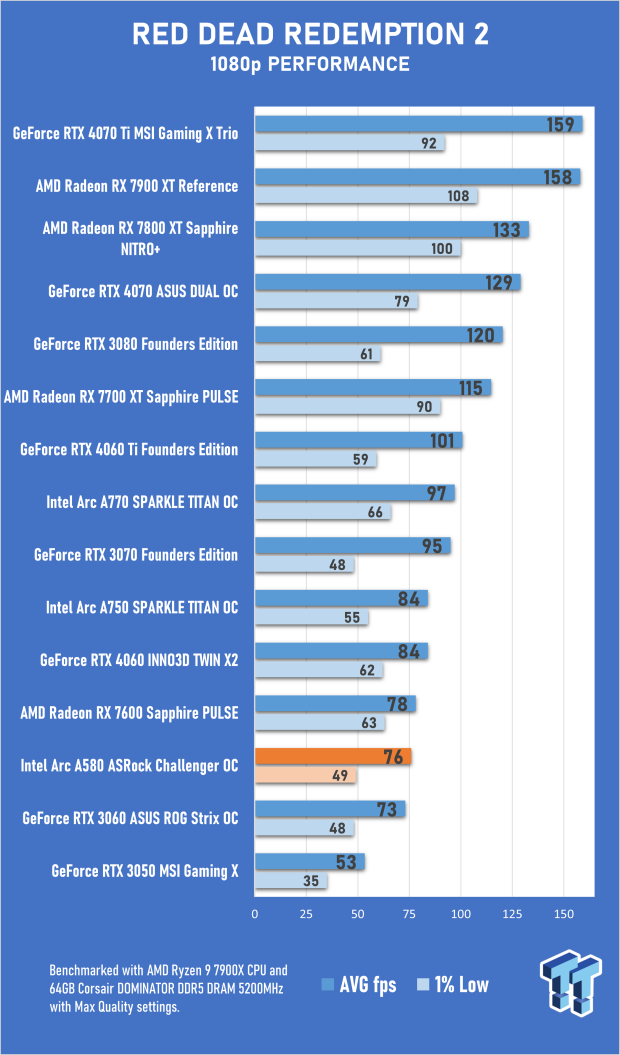
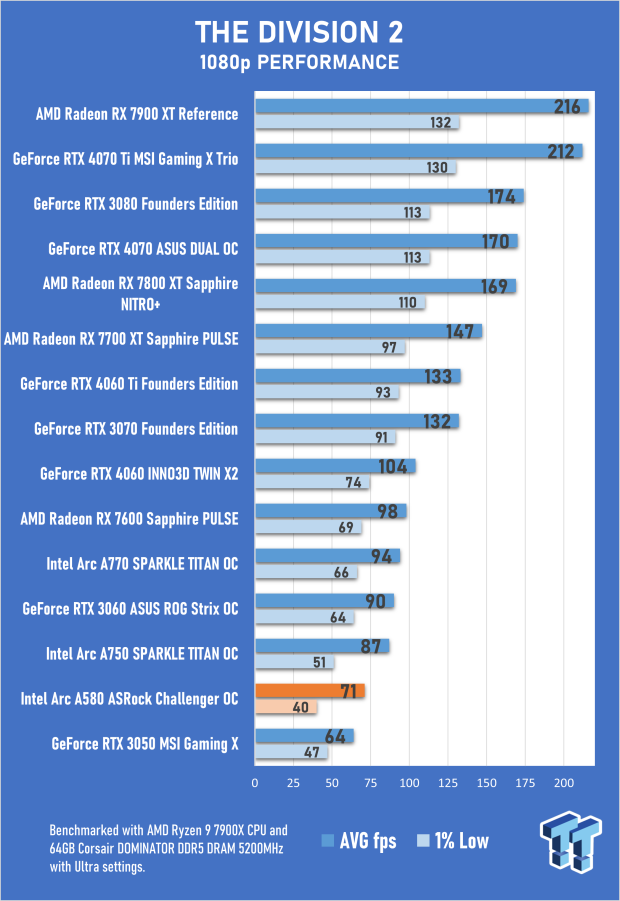
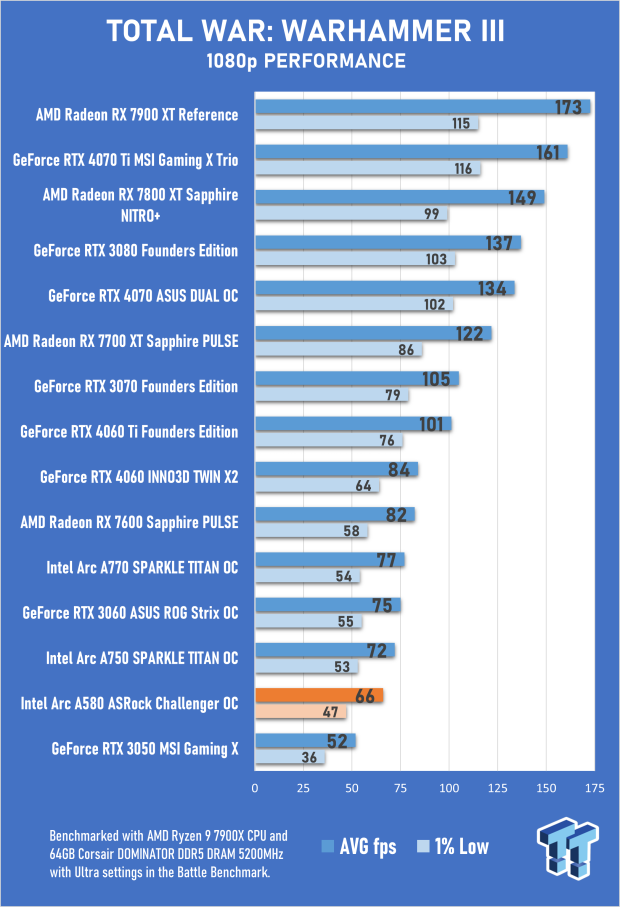
Benchmarks - 1440p Gaming
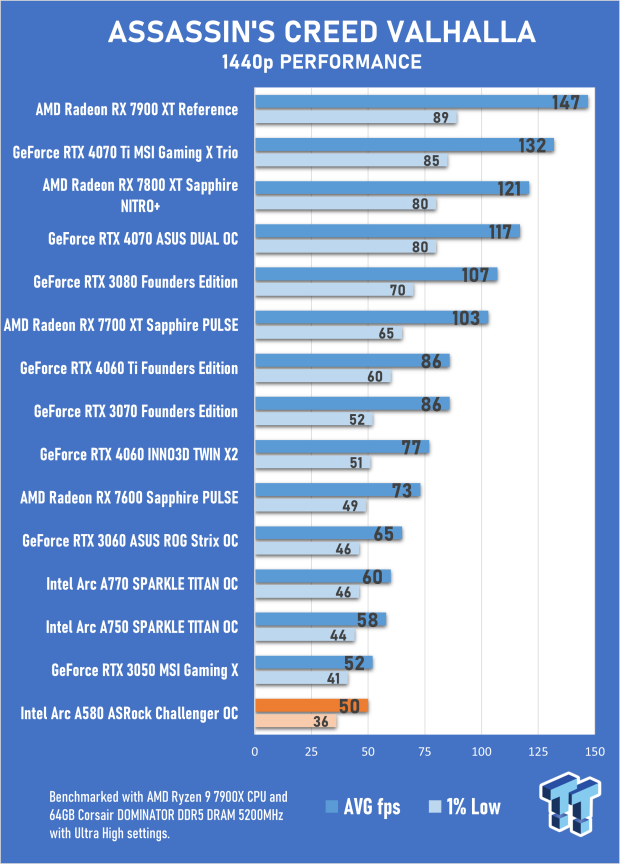
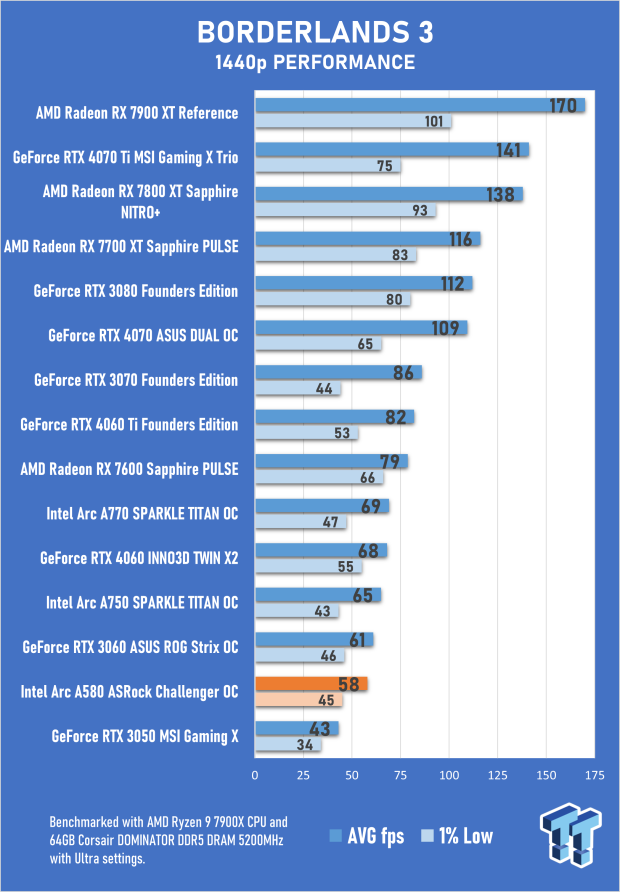
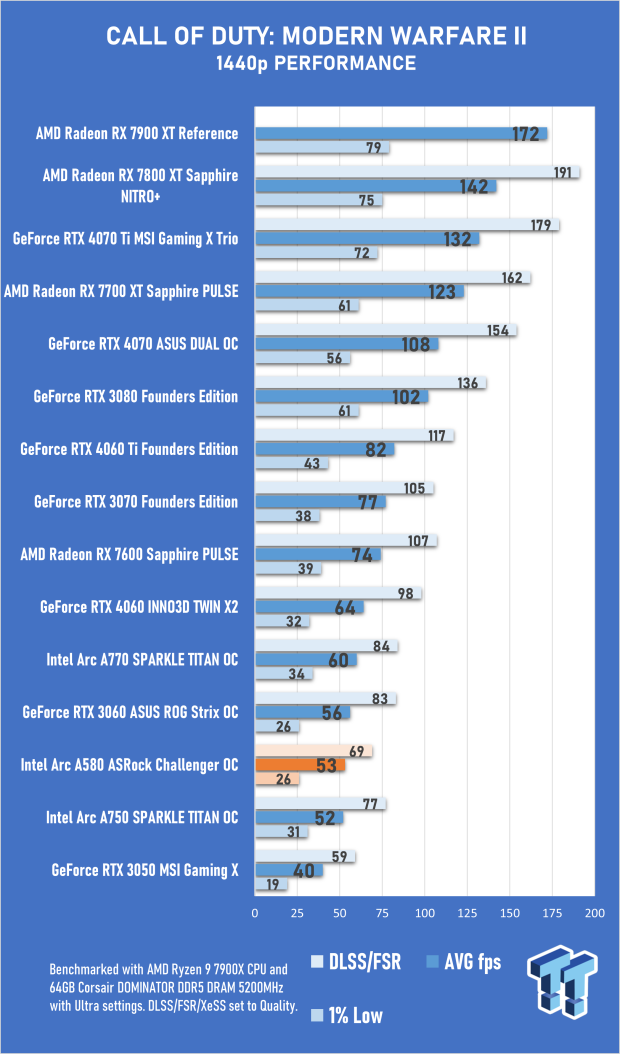
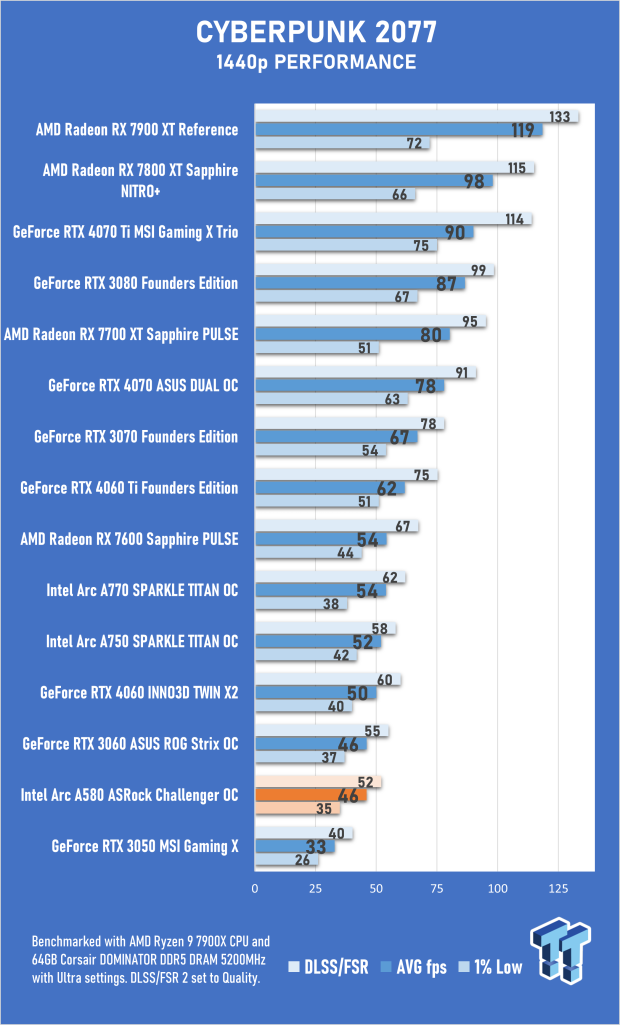
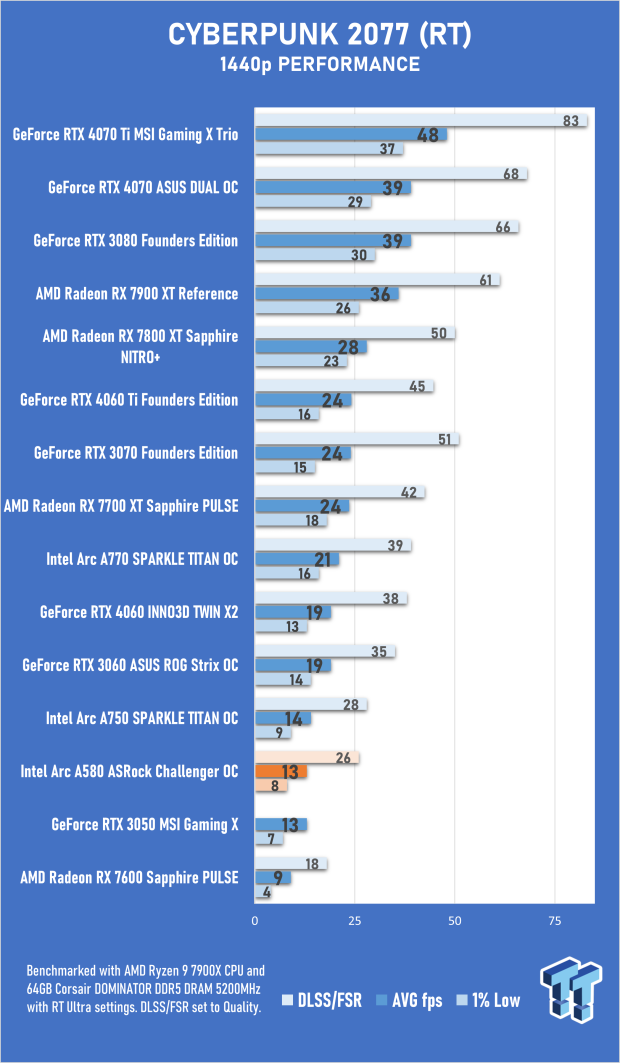
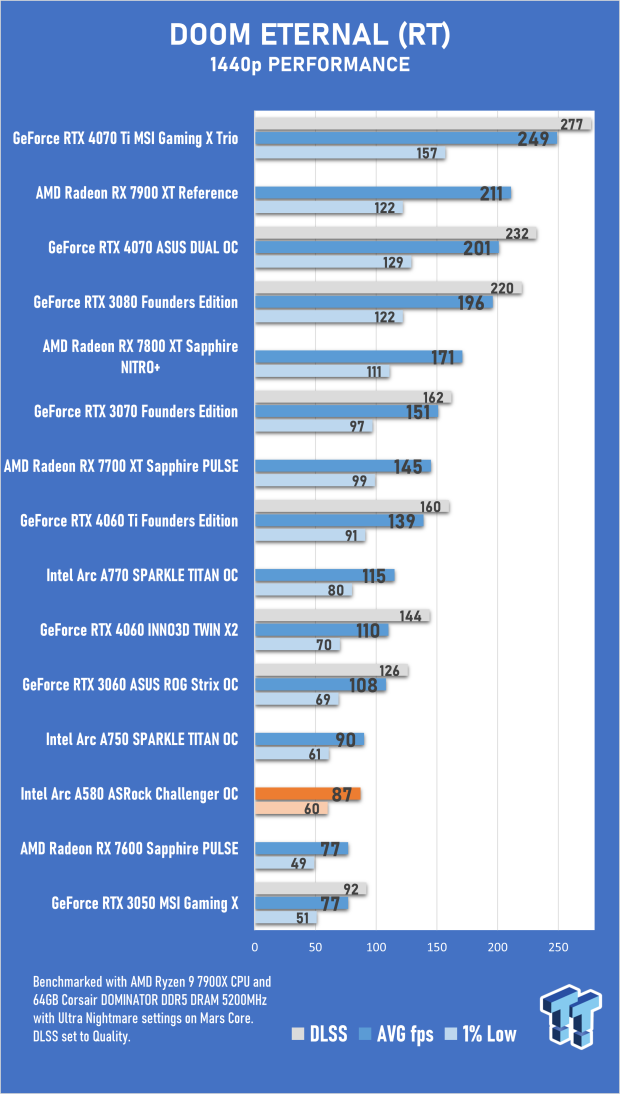
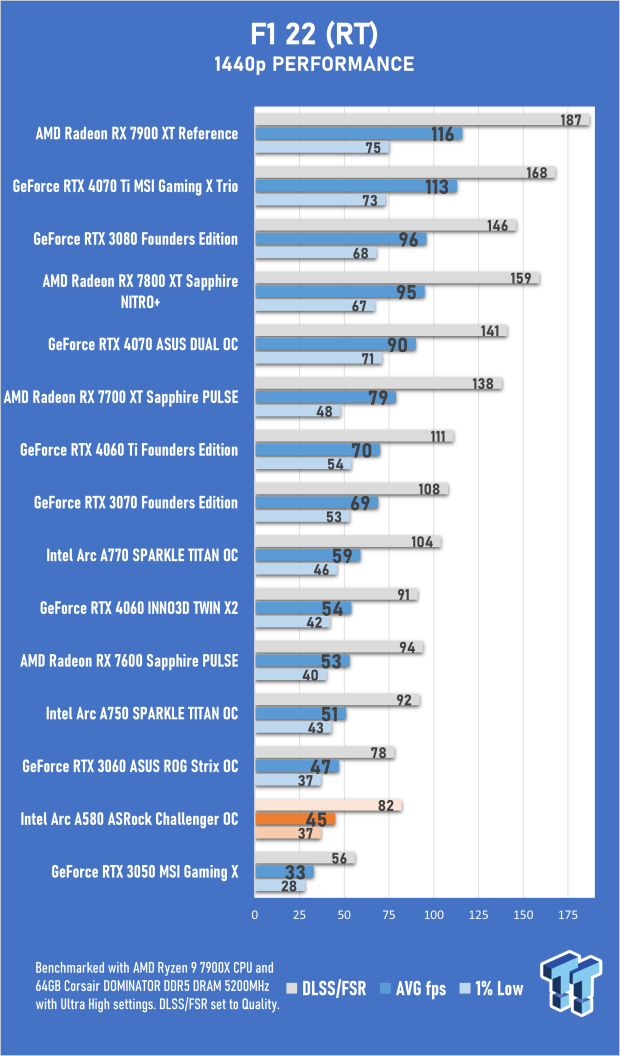
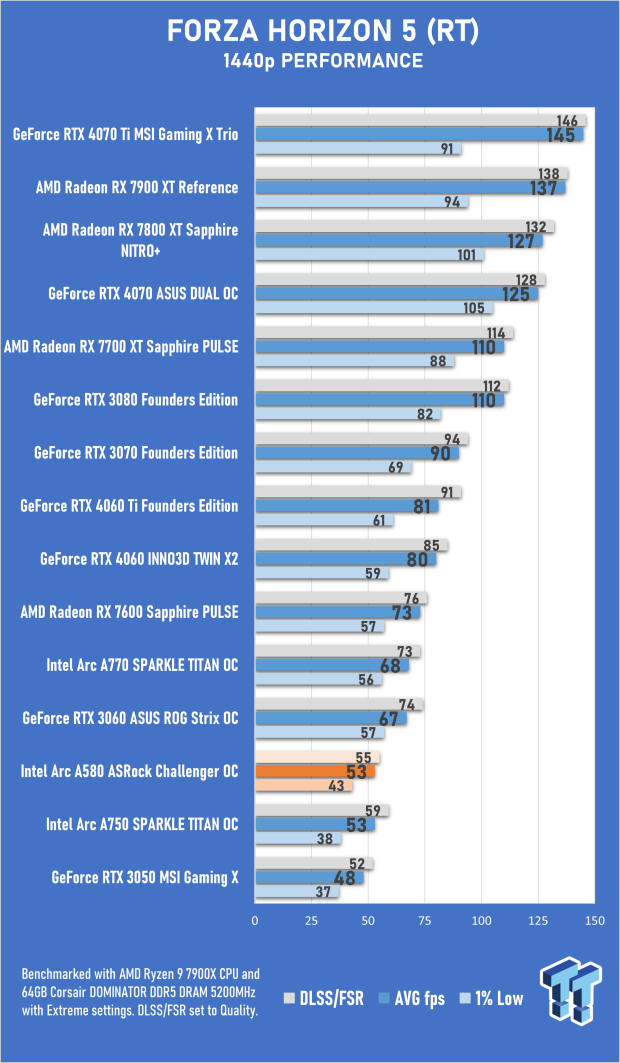
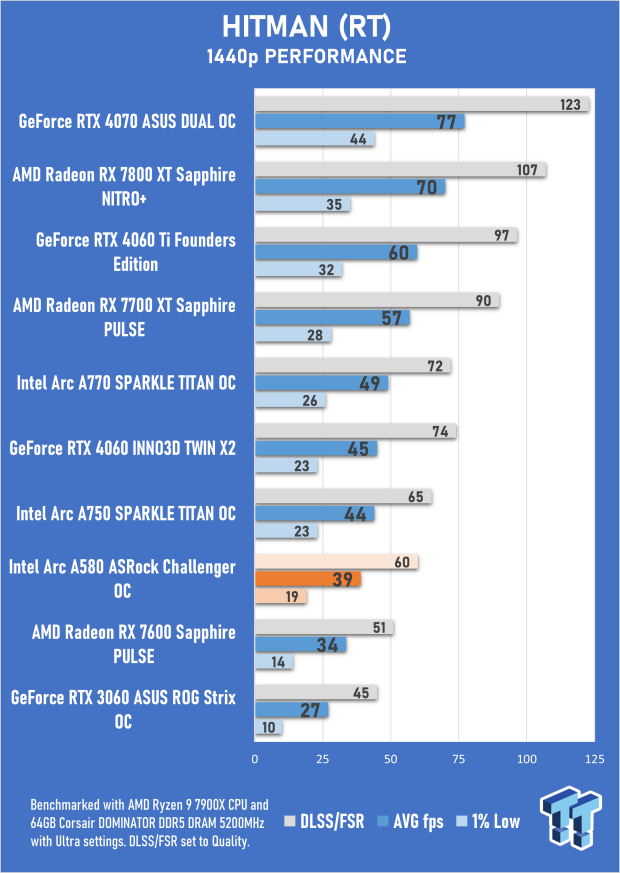
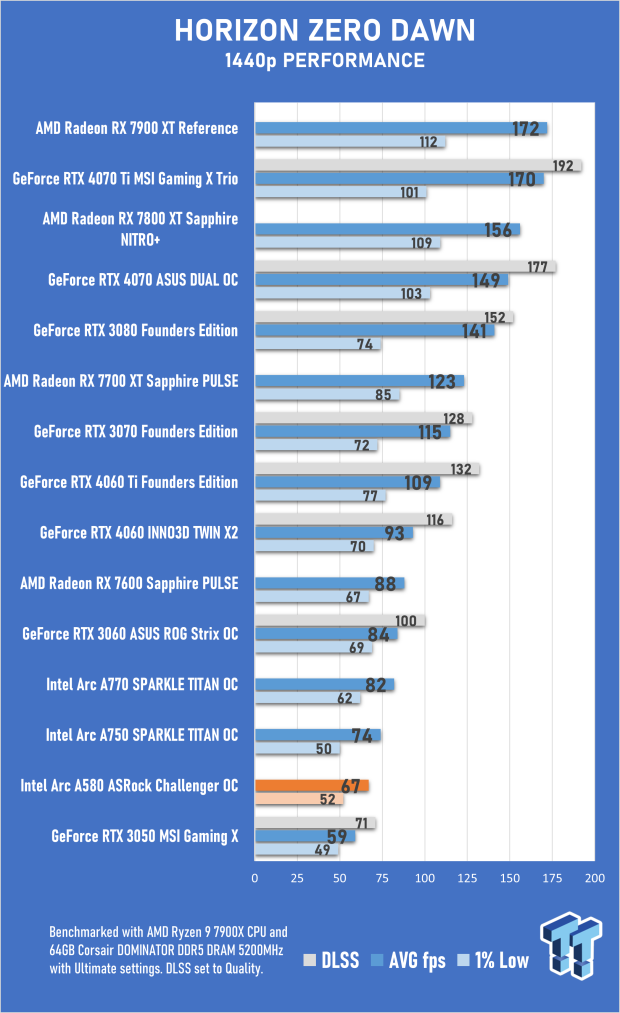
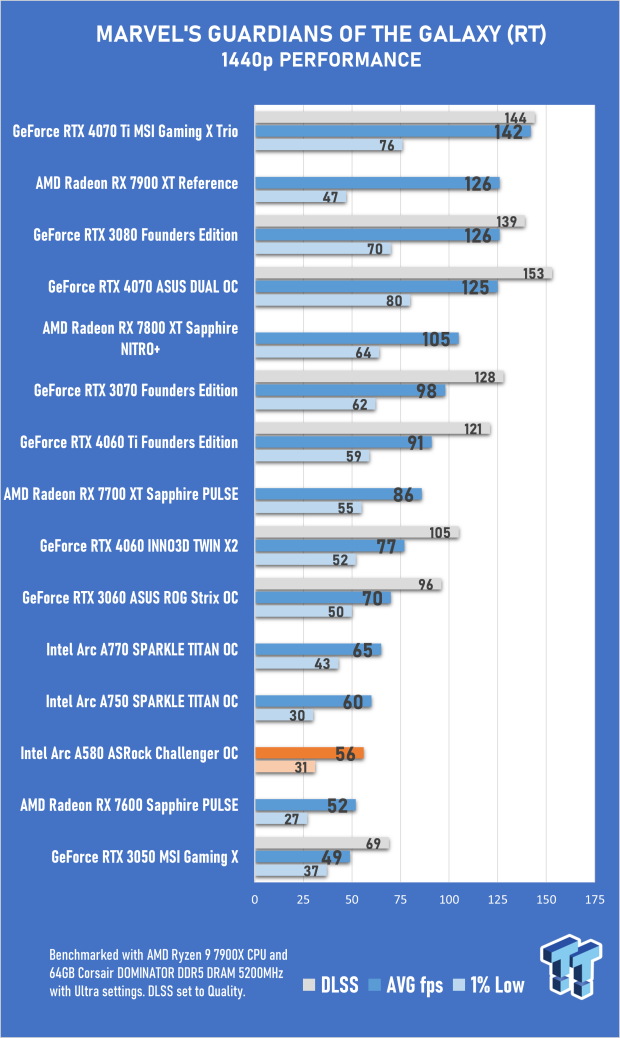
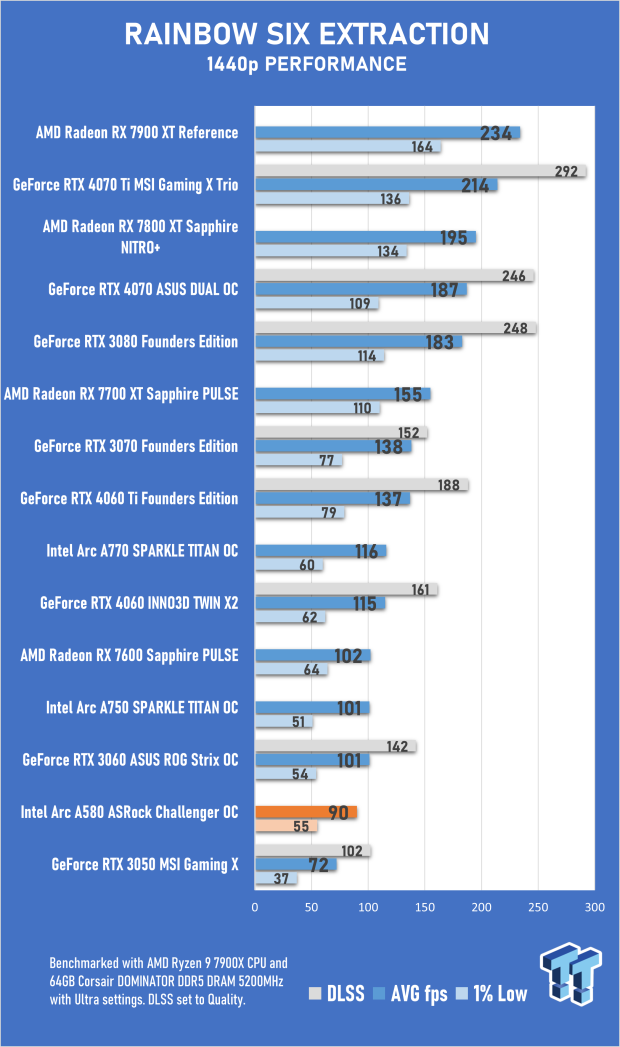
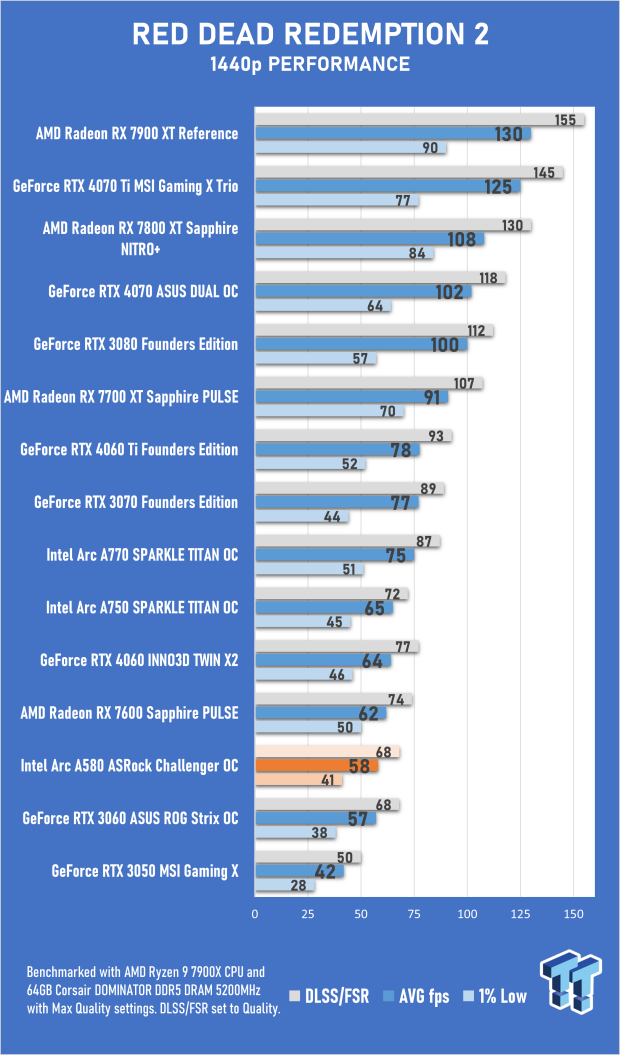
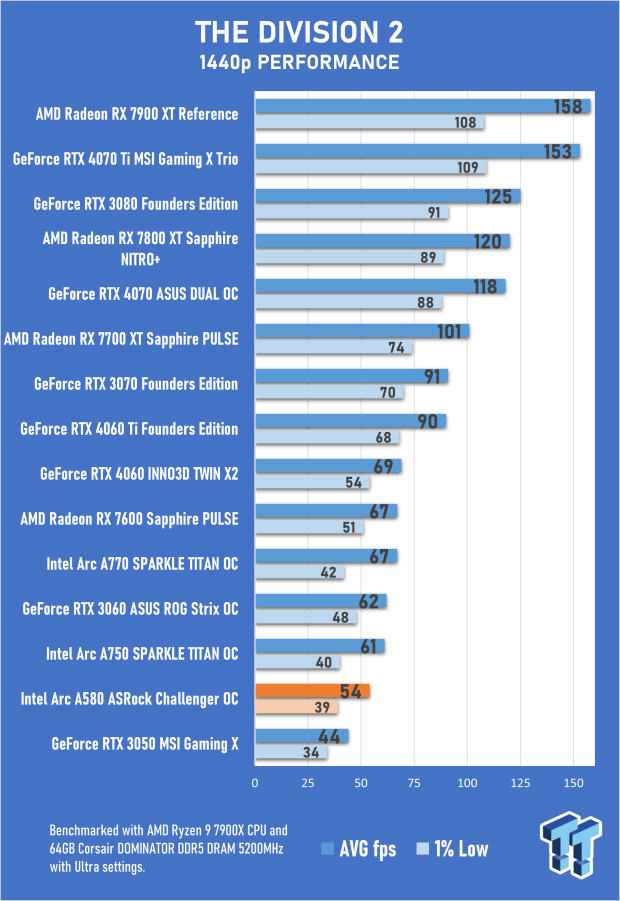
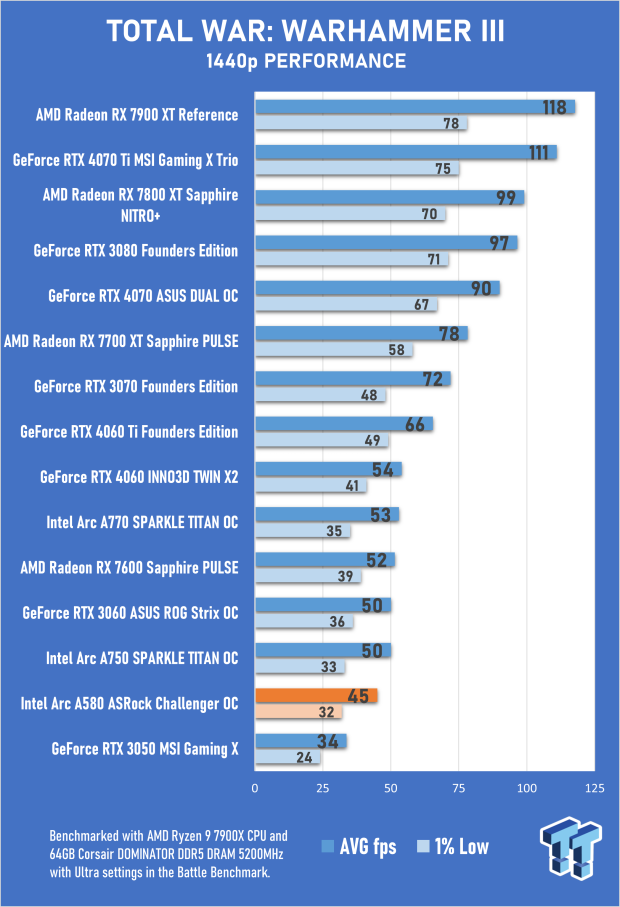
Benchmarks Summary, Ray-Tracing Performance, and XeSS
For $179, you're getting decent 1080p gaming performance with the ASRock Intel Arc A580 Challenger and surprisingly good ray-tracing. RT is still incredibly taxing on hardware, so when you're at the price point where every ounce of raw performance matters - perhaps it's not something you'd enable. However, the fact that you can and still experience a very playable, detailed, and immersive experience is worth celebrating. Take ray-tracing out of the equation, and maintaining a solid 60fps in most games is entirely possible with the ASRock Intel Arc A580 Challenger.
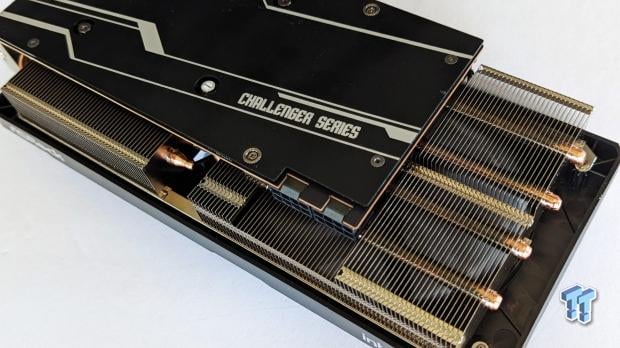
To boost performance, like NVIDIA has DLSS and AMD has FSR, Intel's XeSS offers upscaling with a focus on maintaining image quality. Results vary across all three, and in terms of adoption, XeSS is lagging behind the hundreds of games with DLSS, but the image quality is closer to NVIDIA's impressive tech than FSR. This is because Intel also uses AI hardware inside its GPUs. Even though Intel XeSS works on non-Intel GPUs, it looks better on an Arc GPU because it has that added layer of AI magic.
Also, it's worth mentioning that 2023 saw Intel release multiple driver updates for the Intel Arc range, dramatically improving performance across a range of DirectX 11 and 12 titles. The driver team makes adjustments and optimizations on a per-game basis, so it doesn't sound like there's going to be an update that fixes everything in one go. As we head into 2024, the tech is stable and reliable - which is good news for the future of Arc.
Temperature and Power Efficiency
Thermal performance for the ASRock Intel Arc A580 Challenger is impressive; temperatures, however, are at around 75 degrees, with fan speeds kept in check. Memory temperature did climb to 80 degrees in our stress test, which is fine and nowhere near the level where throttling would occur. Compared to the SPARKLE model we tested, the ASRock Intel Arc A580 Challenger stabilized at similar temps, but fan speeds were slower, and the overall performance was quieter.
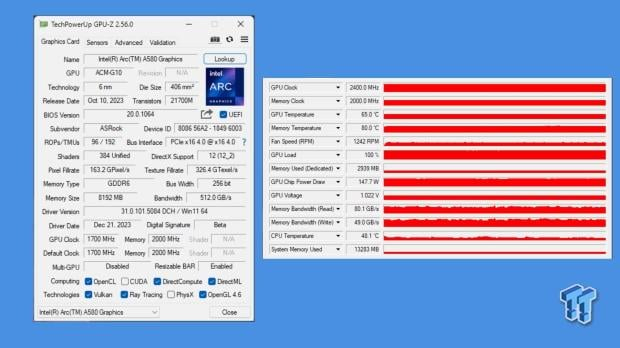
The downside comes with efficiency, where you've got high idle power usage (compared to the competition) with the Arc A580 and overall peak power usage that is higher, too. Entry-level cards are great for small builds where you don't have to worry about slapping in a high-capacity power supply - so the Intel Arc A580 is a step behind in this regard.
Final Thoughts
With the ASRock Intel Arc A580 Challenger, it feels like Intel is slowly starting to carve a slice of the discrete GPU market space for itself - the entry-level and affordable mainstream. For $179, you'd be hard-pressed to find a GPU that can deliver solid 1080p gaming performance with ray tracing that isn't heavily discounted or secondhand. The Intel Arc A580 is nearly 20% faster than the GeForce RTX 3050, a GPU in the same price range. The overall results aren't nearly as exciting as what you'd find with a GeForce RTX 4070 or Radeon RX 7800 XT, but that's not what entry-level bang-for-your-buck products are about.
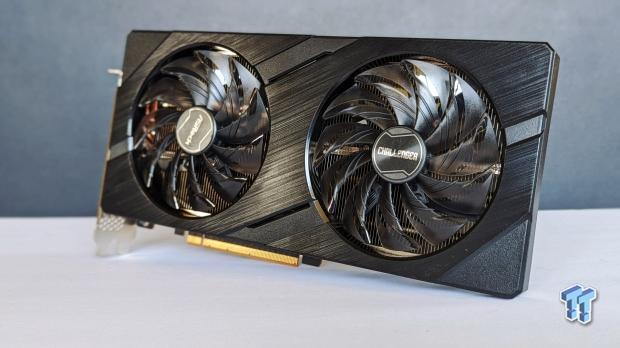
There are still some outstanding Intel Arc issues, imperfect drivers, having to pair it with a modern CPU with Resizable BAR, and value-add features like XeSS upscaling that aren't as widely adopted as the competition. However, for $179, you're not going to get everything - but with ASRock's minimal and robust compact design, there's excellent value.

